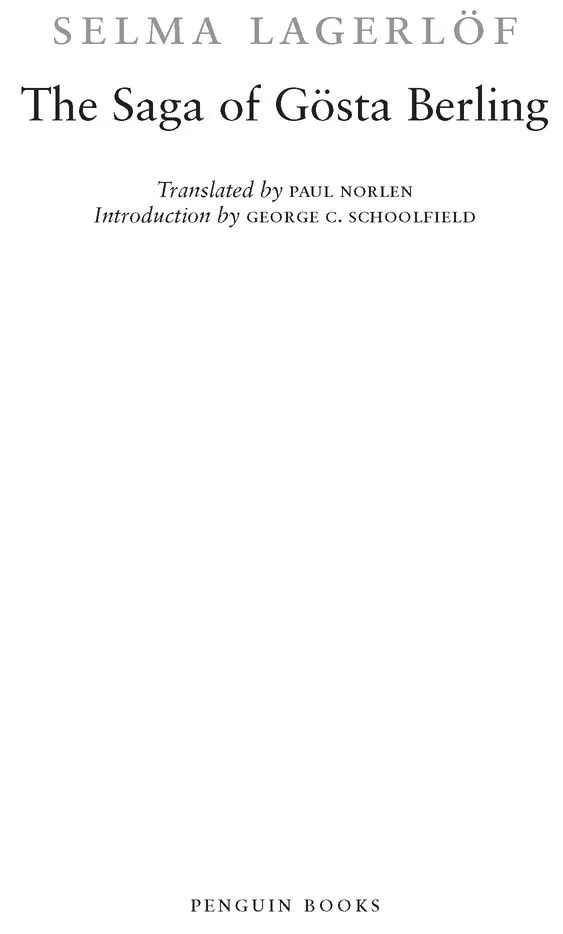The Saga of Gosta Berling

Table of Contents
Title Page
Copyright Page
Introduction
CHAPTER 1 - THE LANDSCAPE
CHAPTER 2 - CHRISTMAS NIGHT
CHAPTER 3 - CHRISTMAS DINNER
CHAPTER 4 - GÖSTA BERLING, THE POET
CHAPTER 5 - LA CACHUCHA
CHAPTER 6 - THE BALL AT EKEBY
CHAPTER 7 - THE OLD CONVEYANCES
CHAPTER 8 - THE GREAT BEAR IN GURLITA BLUFF
CHAPTER 9 - THE AUCTION AT BJÖRNE
CHAPTER 10 - THE YOUNG COUNTESS
CHAPTER 11 - GHOST STORIES
CHAPTER 12 - EBBA DOHNA’S STORY
CHAPTER 13 - MAMSELL MARIE
CHAPTER 14 - COUSIN KRISTOFFER
CHAPTER 15 - THE PATHS OF LIFE
CHAPTER 16 - PENANCE
CHAPTER17 - IRON FROM EKEBY
CHAPTER 18 - LILLIE CRONA’S HOME
CHAPTER 19 - THE WITCH OF DOVRE
CHAPTER 20 - MIDSUMMER
CHAPTER 21 - LADY MUSICA
CHAPTER 22 - THE MINISTER OF BROBY
CHAPTER 23 - SQUIRE JULIUS
CHAPTER 24 - THE CLAY SAINTS
CHAPTER 25 - GOD’S PILGRIM
CHAPTER 26 - THE CEMETERY
CHAPTER 27 - OLD BALLADS
CHAPTER 28 - DEATH THE LIBERATOR
CHAPTER 29 - DROUGHT
CHAPTER 30 - THE CHILD’S MOTHER
CHAPTER 31 - AMOR VINCIT OMNIA
CHAPTER 32 - THE GIRL FROM NYGÅRD
CHAPTER 33 - KEVENHÜLLER
CHAPTER 34 - BROBY MARKET
CHAPTER 35 - THE FOREST CROFT
CHAPTER 36 - MARGARETA CELSING
THE STORY OF PENGUIN CLASSICS

THE SAGA OF GÖSTA BERLING
SELMA LAGER LARGERLÖF (1858-1940) was born and raised in the Swedish province of Värmland. She was teaching at a girls school in Landskrona when she was awarded a literary prize for what would become five chapters of The Saga of Gösta Berling (1891). Becoming a full-time writer after 1895 allowed her to travel to Italy and the Near East, where she gathered material for novels such as Jerusalem (1901-2). Her best-known work internationally, The Wonderful Adventures of Nils (1907), was conceived as a geography textbook for Swedish schools. Lagerlöf’s success allowed her to buy back her childhood home, Mårbacka, sold at auction after the death of her father. In 1909 Lagerlöf became the first woman—and first Swedish author—to receive the Nobel Prize in Literature. Five years later she became the first woman elected to the Swedish Academy. Her later works include The Emperor of Portugallia (1914) and several memoirs, including the remarkable Diary of Selma Ottilia Lovisa Lagerlöf (1932). Many of her books have been made into films, most notably perhaps The Saga of Gösta Berling in 1924. Lagerlöf was a widely known and respected public figure in Sweden and abroad, a position that often placed heavy demands on her time and energy. She died at Mårbacka on March 16, 1940.
PAUL NORLEN is a past winner of the American Scandinavian Foundation Translation Prize.
GEORGE C. SCHOOLFIELD is professor emeritus of German and Scandinavian literature at Yale.

BookishMall.com
Published by the Penguin Group
Penguin Group (USA) Inc., 375 Hudson Street, New York, New York 10014, U.S.A.
Penguin Group (Canada), 90 Eglinton Avenue East, Suite 700, Toronto, Ontario, Canada M4P 2Y3
(a division of Pearson Penguin Canada Inc.)
Penguin Books Ltd, 80 Strand, London WC2R 0RL, England
Penguin Ireland, 25 St Stephen’s Green, Dublin 2, Ireland (a division of Penguin Books Ltd)
Penguin Group (Australia), 250 Camberwell Road, Camberwell, Victoria 3124, Australia
(a division of Pearson Australia Group Pty Ltd)
Penguin Books India Pvt Ltd, 11 Community Centre, Panchsheel Park, New Delhi - 110 017, India
Penguin Group (NZ), 67 Apollo Drive, Rosedale, North Shore 0632, New Zealand
(a division of Pearson New Zealand Ltd)
Penguin Books (South Africa) (Pty) Ltd, 24 Sturdee Avenue, Rosebank, Johannesburg 2196, South Africa
Penguin Books Ltd, Registered Offices:
80 Strand, London WC2R 0RL, England
This translation first published in Penguin Books 2009
Translation copyright © Paul Norlen, 2009
Introduction copyright © George C. Schoolfield, 2009
All rights reserved
Gosta Berlings Saga was published in Sweden in 1891.
LIBRARY OF CONGRESS CATALOGING IN PUBLICATION DATA
Lagerlöf, Selma, 1858-1940.
[Gösta Berling’s saga. English]
The saga of Gösta Berling / Selma Lagerlöf ; translated [from the Swedish] by Paul Norlen ;
introduction by George C. Schoolfield.
p. cm.—(Penguin classics)
eISBN : 978-1-101-14048-2
I. Norlen, Paul R. II. Title.
PT9767.G6E54 2009
839.73’72—dc22 2009027532
The scanning, uploading and distribution of this book via the Internet or via any other means
without the permission of the publisher is illegal and punishable by law. Please purchase only
authorized electronic editions, and do not participate in or encourage electronic piracy
of copyrighted materials. Your support of the author’s rights is appreciated.
http://us.penguingroup.com
Introduction
Selma Ottilia Lovisa Lagerlöf was born on November 20, 1858, at Mårbacka, her parents’ small estate in the Swedish province of Värmland. She was the third child of Erik Gustaf Lagerlöf, a sometime lieutenant in the Royal Värmland Regiment, and Louise Lagerlöf, née Wallroth, whose father was a well-to-do merchant and brukspatron or “foundry owner.” The paternal side of the family had many pastors over the generations, including the poet and churchman Esaias Tegnér, of whose verse epic, Frithiofs saga (1825), about a Viking with Byronic overtones, Erik Gustaf was inordinately fond. Erik Gustaf’s widowed mother lived with the family, and was the teller of the Värmland tales Selma heard in the nursery; the lieutenant’s spinster sister, Lovisa, occupied the spacious pantry of the main house. Selma’s older and younger sisters, Anna and Gerda, were both prettier than she, and would readily find husbands, as did Erik Gustaf’s sister Anna, who wed the dashing, improvident noncommissioned officer Carl von Wachenfeldt, and died after seventeen years of marital misery. Lagerlöf described von Wachenfeldt—he sounds not a little like Gösta Berling—in her first memoir volume (Mårbacka, 1922), where he is called, punningly, Vackerfeldt, “Pretty-field.” Graying and wrinkled, he became a hanger-on at the estate. Two brothers, Daniel, the eldest sibling, who became a physician, and Johan, who immigrated to America, completed the family roster.
Selma was plain and slightly lame. The cross-country wanderings of the majoress and Elisabet in The Saga of Gösta Berling may be the author’s compensatory fantasies.
1 comment